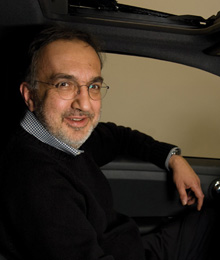The Little Fiat that Could
April 13, 2012 by Michael Hill
Filed under Auto
 Anticipation hovers over the crowd at Maranello Fiat’s grand opening celebration. Guests mingle, sip spirits and ogle the new 500s occupying the showroom floor. But it’s not a car this party is waiting for – it’s the man who saved Fiat, who reintroduced the beloved 500 to the world, that’s on their minds. And as he’s ushered through the doors of Fiat’s Canadian flagship dealer, the crowd’s response says it all: Sergio Marchionne has arrived.
Anticipation hovers over the crowd at Maranello Fiat’s grand opening celebration. Guests mingle, sip spirits and ogle the new 500s occupying the showroom floor. But it’s not a car this party is waiting for – it’s the man who saved Fiat, who reintroduced the beloved 500 to the world, that’s on their minds. And as he’s ushered through the doors of Fiat’s Canadian flagship dealer, the crowd’s response says it all: Sergio Marchionne has arrived.
CEO of Fiat S.p.A and Chrysler Group LLC, Marchionne is the biggest name in the automotive world today. Heading Italy’s largest industrial empire, he has plucked both companies from the precipice of death, transforming these once-hemorrhaging enterprises back into serious players. “There was certainly risk involved in taking on Chrysler,” Marchionne says of the American automotive company that Fiat acquired in 2009. But with risk comes reward. As Marchionne explains, each brand has its strong suit. Fiat, with its smaller, fuel-efficient cars, and Chrysler, its strength in medium-to-large vehicles, the match was made in automobile heaven. “What we saw was an incredible opportunity to bring Fiat and Chrysler together to achieve the critical mass necessary to produce large economies of scale to justify the enormous levels of investment required by the automotive business,” says the Italian-born 59-year-old who spent his younger years living in Canada.
With cameras flashing and a swarming crowd that includes Dragons’ Den star Robert Herjavec, Marchionne, uniformed in his trademark black sweater over a collard shirt, stands calmly between a classic 500 and its modern kin. After a brief window for media to photograph him alongside Remo Ferri, president of Remo Ferri Group of Automobiles, and Reid Bigland, president and CEO of Chrysler Canada, he begins to move towards the stage. But Marchionne can barely take a step without a handshake thrust towards him or a plea for a quick snapshot.
http://www.citylifemagazine.ca/wp-admin/post.php?action=edit&post=10709&message=1
Their enthusiasm is certainly justified. Not long ago, a metaphorical sign hung from Chrysler factories reading, ‘Abandon all hope, ye who enter here.’ And now, standing before them, is the man who tore it down. Last year, Chrysler posted a $183-million profit while also paying back its $6-billion bailout six years before its due date.
They say history tends to repeat itself, and with this rapid resurrection, it’s hard not to think of Lee Iacocca, Chrysler’s president and CEO from the late ’70s to early ’90s, who launched the Dodge Caravan and the Plymouth Voyager, which helped revive the company during the ’80s.
“I believe the essence of leadership is assumption of the moral duty to take an active part in building the future of the organization and of society as a whole,” says Marchionne of his leadership style – a statement backed by his reorganization of Chrysler’s archaic bureaucratic management structure. Through a near-complete changing of the guard, a tactic he also applied at Fiat years earlier, Marchionne uncovered 26 young, overlooked leaders from within Chrysler to help guide it into a renaissance. “What I have learned from my experience as a chief executive is that culture is everything,” he says. “A change in culture is something much deeper and longer-lasting than a simple change in industrial or commercial practices.”
Often labelled a workaholic for his relentless work schedule, which is split between Fiat’s headquarters in Turin, Italy and Chrysler’s in Auburn Hills, Michigan, Marchionne prefers to immerse himself in the organization as opposed to commanding above it. “Nothing happens on the 15th floor,” he says of the move to bring his Chrysler office from the top floor to the fourth. “My neighbour on one side is the head of engineering and on the other side is the head of manufacturing. I can build a car with the people on the fourth floor. That’s what I care about.”
Marchionne and his entourage finally make it to the stage and a hush falls over the crowd. Ferri, a boyhood friend of Marchionne’s, grabs the mic and welcomes the audience. “I must say that I’m very, very happy to see Fiat back,” he says to a round of applause. “I was much more convinced with Fiat coming back because I saw the leadership that Fiat was taking.”
Interestingly enough, Marchionne’s ascension to the Fiat helm was quite serendipitous. “Ironically, the Agnelli family picked Sergio Marchionne as CEO of Fiat as a sort of pinch-hitter or emergency choice,” says Jennifer Clark, author of Mondo Agnelli: Fiat, Chrysler, and the Power of a Dynasty (Wiley, 2011). When Gianni Agnelli, past president of Fiat and grandson of its founder Giovanni Agnelli, died in 2003, the company was already in dire straits. Gianni’s brother Umberto took over, but died of cancer in 2004, “leaving the family leaderless and the company without a chairman.” Giuseppe Morchio, Fiat’s then-CEO, offered to take control, but the Agnelli family feared this would give him too much power. They refused. He resigned. In desperation, the family turned to Marchionne, who was already a member of Fiat’s board, and successfully running another one of their companies in Switzerland, asking him to take up the mantle of CEO in 2004. As Clark explains, “It was one of the hardest decisions he ever made, because the company was losing millions each day.” But the move paid off. In 2005, Fiat had its first profitable quarter in years and has been making strides ever since.
As Ferri wraps up his speech and welcomes the Fiat-Chrysler CEO to the stage, Marchionne expresses what a great pleasure it is to be back in Ontario, a province he once called home, and to spend time with his long-time friend and fellow Ferrari enthusiast. “One of the things that Remo and I share is the incredible passion for Ferrari. In fact, I did pick up my only North America Ferrari [a 430 Scuderia Spider] here from Remo last year,” says Marchionne, while hinting at possibly purchasing a black California this time around.
But after the pleasantries, Marchionne shifts to business. “Chrysler gained the most market share of any company in Canada in both 2010 and 2011,” he says. “So far, in 2012, we’re the No. 1 seller of vehicles in this country.” He adds that Fiat, which was once struggling with its relaunch into North America, was now on track. “In 2011, the 500 in Canada outsold the Mini Cooper by 50 per cent, and it’s more than doubling it so far this year,” he says to more applause. “And I’m confident we’re on our way to becoming a permanent part of the automotive landscape here in Canada.”
After his speech, Marchionne reiterates his plans to bring Alfa Romeo back to Canada in 2014, and to introduce a new five-seat Fiat 500L and electric 500 next year. But even with all these successes – saving 300,000 American jobs connected to Chrysler through its industrial supply chain, rolling out the Dodge Dart, the first compact sedan Chrysler has produced in over a decade, and making both car companies profitable again – Marchionne remains reserved, instead crediting the work of Fiat and Chrysler’s employees for their success. “The important thing now is to stay humble and maintain the discipline that the restructuring forced, so that we can reap the benefits of the changes that have been made.” And with Marchionne at the wheel, the horizon looks bright.
Q & A with Sergio Marchionne
CL: Your father was a member of the Carabinieri (national military police of Italy). What did he teach you about life, and how did it shape your attitude towards business?
SM: As an officer with the Carabinieri, which would perhaps be similar to the Mounties here in Canada, he passed on to me some of the most precious things in life. He taught me about integrity, civic responsibility and the sense of duty: moral values by which a sense of responsibility always prevails over indifference, action over disinterest, conscientiousness and dedication over the fashion of the day.
CL: It’s rumoured that you prefer to wear lace-less shoes because it saves time. What is the value of time in this type of industry?
SM: It’s about allocating time and resources. I like simplicity almost to the point of being monastic. That’s why I made a decision to start wearing black sweaters and pants. I don’t want to spend the three seconds deciding whether to wear a blue one or a black one. Wearing lace-less shoes and growing a beard also saves time and helps [to] make my life a little easier.
CL: What’s your favourite Fiat? Do you own any classic Fiats? If so, which ones, and why?
SM: My favourite car among the Fiat-Chrysler range? That’s like asking a parent to pick his favourite child! No, actually I don’t own any classic cars, but what I can tell you is that my very first car was a Fiat 124 Spider, a gift on my 16th birthday … or maybe a sign of destiny. And now I have some Ferraris, which I almost never drive, unless I find the time to race them on a track. What I drive here is a Charger, a bit modified, but a Charger. In Europe, either I drive a Chrysler 300 or a Grand Cherokee. But my personal garage has a lot of room and lots of cars, including a special matte black version of a 500.
CL: You’ve now helped pull two companies from the precipice of bankruptcy. What’s been the key to making both Fiat and Chrysler major players again?
SM: Simply put: the people. Organizations, when all is said and done, are but a collection of the collective will and aspirations of their people. Every success story is based on the ability of men and women to drive cultural change on a certain order of things. Like any other business, Fiat and Chrysler needed to embrace the challenge of the new and see the future as a huge opportunity. They needed to live the culture of change as a necessity, of feeling comfortable in the discomfort associated with uncertainty, of measuring itself each day and of rooting itself in the values of competition and the market.
And now that the men and women of Fiat and Chrysler have been to hell and back, they have learned to look at the world in a different way than before, like a survivor does. We have gained strength from the experience of overcoming adversity. We don’t shy away from making tough decisions, and we are able to adapt to challenges. And the decisions we make are informed by the experience of near-extinction and a resolve to never again get so perilously close to demise.
















Comments
Feel free to leave a comment...
and oh, if you want a pic to show with your comment, go get a gravatar!